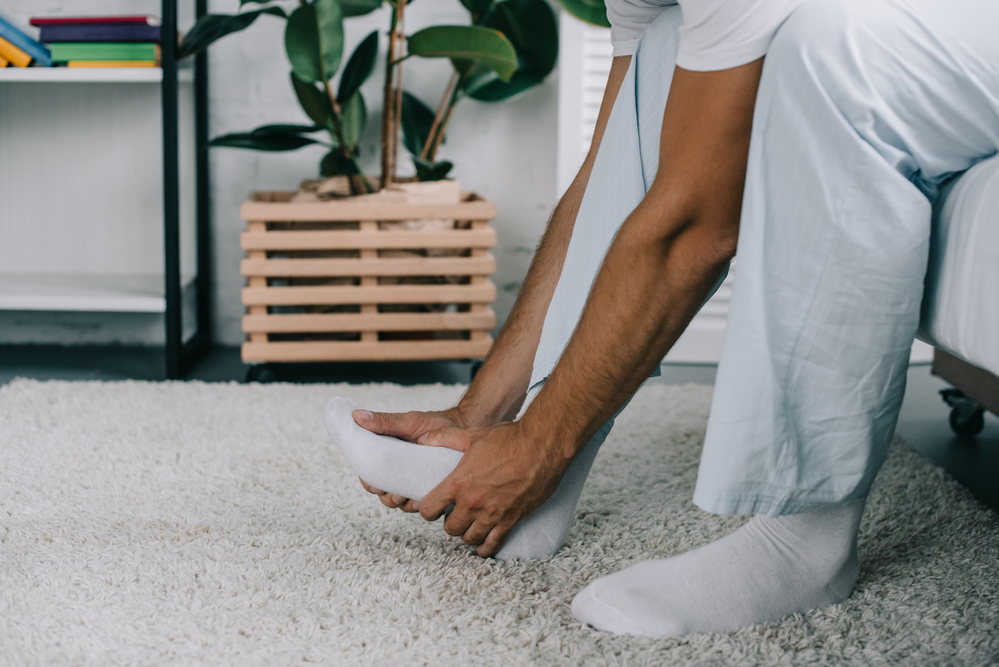Foot pain is a common condition that occurs due to overuse, injury, and conditions that affect tendons, ligaments, and bones. It usually affects the toes, arches, soles, and heels. If you’re experiencing persistent pain in your feet, it’s vital to visit a foot clinic for diagnosis and treatment. At Island Foot Clinics in British Columbia, we strive to provide the best possible treatments for different types of foot and ankle disorders.
What Could Be the Cause of Your Foot Pain?
Arthritis
Arthritis usually affects the joints, and it’s characterized by tenderness and swelling in the joint. The main symptoms are usually stiffness and pain, and they tend to worsen with age. Keep in mind that there are different types of arthritis, but the most common types are rheumatoid arthritis and osteoarthritis.
Osteoarthritis usually affects the cartilage, causing it to break down. In rheumatoid arthritis, the immune system attacks healthy cells in the joints. There are conditions, such as lupus and psoriasis, that can cause some types of arthritis. We’ll determine the cause of your arthritis before recommending the ideal treatment methods for you.
Injuries
The feet account for nearly one-fourth of the bones in the human body. When one of these bones gets fractured, you’ll experience pain. In some cases, such injuries can resolve without major treatment, while other cases will need medical intervention. These injuries can occur due to intensive exercise, impact with heavy objects, or improper training techniques.
The severity of the injury usually depends on the impact of the incident. For example, severe cases may manifest with a fractured bone that breaks through the skin. This is known as an open fracture. In a closed fracture, the bone doesn’t break through the skin. Unnatural twisting of the foot can also lead to ankle sprains. All these cases lead to pain and swelling.
Athlete’s Foot
The is a fungal infection of the skin that’s commonly found between the toes. If left untreated, it usually spreads, leading to itching, peeling, blistering, and crackling. You can easily get exposed to the fungus while walking barefoot in public places, such as pools, shower, and gym. Wearing damp and warm shoes usually speeds up the spread and growth of the fungus.
This condition can spread to your hands, scalp, and groin if ignored. Our doctors will provide antifungal treatments, such as lotions, sprays, and powders, to help manage the issue. Be sure always to keep your feet clean and dry to avoid this condition.
Bunions
Another common cause of foot pain is a bunion, which is a bony bump that occurs at the joint of the big toe. It usually forms when bones in your foot dislocate, pulling the big toe towards the smaller ones. This, in turn, forces the joint at the base of the big to protrude.
This condition causes pain that usually comes and goes, and it can also lead to swelling, redness, and soreness around the area. Wearing tight, narrow shoes can worsen it. Bunions are commonly caused by injuries and birth deformities.
Blisters
Blisters that develop on the feet occur mostly due to friction or a skin burn. Other possible causes include trauma, insect bite, and fungal or bacterial infections. Blisters can cause pain in the foot, making it difficult to exercise, walk, or even stand for extended periods.
Walking or standing for long periods increases your risk for foot blisters. People who wear poorly fitted shoes are even more likely to get blisters. Understanding the cause of your blisters is essential in ensuring successful treatment.
Fungal Toenails
Also known as nail fungus or toenail fungus, this condition is characterized by yellow or white spots underneath the tip of your toenails. As the fungus spreads deeper, the nail usually thickens and crumbles at the edge. It can become painful, especially when the nail thickens.
If you have a suppressed immune system, fungal toenails can lead to other serious infections. For example, diabetic patients are likely to suffer from cellulitis. Therefore, it’s vital to get medical attention for the condition. Always clean your feet regularly, wear footwear in public places, and avoid using artificial nails and nail polish.
Corns and Calluses
In some cases, your skin tends to try to protect itself from pressure and friction, resulting in hardened layers of the skin known as corns and calluses. Some people might not like the appearance of these issues, and they can become painful if the skin area is continually exposed to friction and pressure.
Corns tend to form on the sides and tops of your toes and sometimes between the toes, while calluses usually occur on the soles. If your corns or calluses are inflamed and painful, you can reach out to us for treatment.
Hammertoe
This condition usually occurs when the second, third, fourth, or fifth toe of your foot bends. Wearing shoes often puts pressure on the affected toe, leading to other problems. Early intervention is essential for hammertoes, as they tend to get rigid and unresponsive to treatment if ignored.
Hammertoes occur due to an imbalance in the tendons and muscles. They cause pain or irritation, especially when wearing shoes, and they can also lead to open sores, redness, and inflammation. This condition can be addressed by non-surgical or surgical treatment options depending on its severity.
Neuroma
Also known as a nerve tumour or a pinched nerve, a neuroma is a painful condition that tends to affect the web space between the third and fourth toes. It’s usually a benign growth of nerve tissue, and patients typically experience tingling, numbness, pain, and a burning sensation.
The main sign is pain, particularly when you’re walking. The exact causes of a neuroma are unclear, but it’s attributed to several factors, such as improper footwear, nerve damage, repeated stress in the foot, and biomechanical deformities. A neuroma tends to worsen if left untreated, so it’s vital to visit our offices as soon as possible for intervention.
Flat Feet
This is a condition wherein the entire sole of your foot touches the floor’s surface while standing. It tends to manifest during childhood when the arches of the feet fail to develop. Other potential causes of flat feet include injury, weak arches, damage to the posterior tibial tendon, and muscle or nervous system diseases.
The most common symptom is usually pain, and this can occur due to strained connecting ligaments and muscles. The pain can spread to other parts of the body, such as inside the ankle, calf, hip, knee, lower back, and lower legs. You might also experience stiffness in your leg.
Get Treatment for Foot Pain Today!
Pain in the foot can affect your everyday life, especially when it makes walking and standing difficult. Home remedies, such as resting, icing, compression, and elevation, can help in the management of mild cases. However, for severe and persistent cases, you need a professional podiatrist to diagnose and treat the issue.
Contact us today at Island Foot Clinics, where we offer expert podiatric care to treat your foot pain problem. We conduct physical examinations and imaging tests to understand your situation before recommending the appropriate treatment. We serve many areas in BC, including Campbell River, Kelowna, Nanaimo, Terrace, Prince George, Kamloops, Osoyoos, Williams Lake, and Victoria. Call us today!

